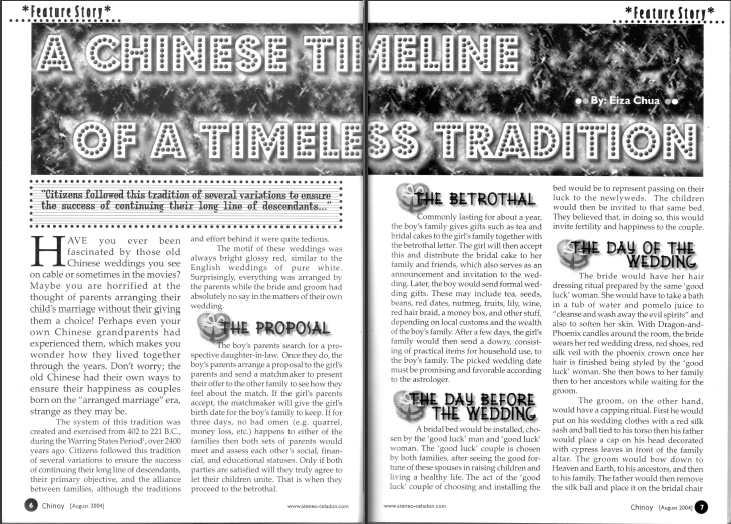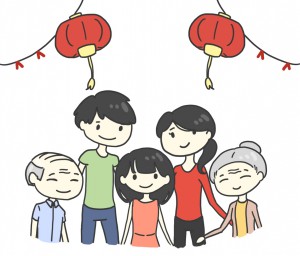Chinese-Filipino relationships are commonly thought to possess Mano Po-esque plots. Most, if not all of us, have an idea about the existence of unspoken rules that currently govern Chinese-Filipino romantic relationships. What could possibly be the rationale behind these rules, which quite a number of Chinese youth today find constricting? To what extent do these rules actually affect those who are subject to them? How have Chinese relationship traditions evolved over the years?
The Tradition of the Arranged Marriage
Chinese marriage as we know it today became custom during the Warring States period (402–221 B.C.) In the olden times, it was customary that a Chinese woman would not be freely allowed to choose a husband. The bride’s parents would be the ones deciding on a partner for their daughter. They would often consult the aid of a “matchmaker” (usually an elder woman) to help find the right man for their child. The matchmaker is paid money to visit various households in her community, asking if there are males fit for marriage, while simultaneously giving recommendations on the children of her other clients. Common practice states that if the family of the woman were attracted to the description of a man, the matchmaker would go to the household of the man and tell his parents about the woman. If the man’s parents were interested, they would then write a letter addressed to the parents of the woman. Finally, if the parents of both sides agree to the final arrangements, the marriage is declared and the preparations for it begin.
A Comparison with Current Ways and Traits
1. Kai Shao
Kai Shao, which literally means “to introduce,” is the process of introducing a single man of marrying age to a single woman (or vice versa). This is commonly observed in modern times by Chinoy families. A much, much lighter version of the arranged marriages, Kai Shao, is usually initiated by the parents, aunts, uncles and other relatives of a single child of marrying age. The main point of this whole process is to find a suitable partner for the man or woman that will hopefully lead to marriage. While there is no coercion to marry the one being introduced, both the man and the woman being introduced may be heavily pressured by their parents (or the one who initiated the Kai Shao) to take the relationship to the next level. Similarities with the ways of the past include researching about a potential spouse’s background, family reputation and social status.
The initiation of Kai Shao is not limited to relatives and elders of the individual. It is also com¬mon for the individual’s friends to introduce him or her to another friend. The difference between this and the introduction by an elder lies in the fact that if the individual does not get along with the other person, “the case is immediately closed” and usually, no subsequent pressure from the friend is given.
2. The Chinese Sense of Family
Kai Shao may also take its root from the high value that Chinese families put on having Ho Mia or family honor. As such, the care put into preserving this honor ex¬tends to the children’s marriage. After all, the children’s matrimo¬nial ceremonies could be consid¬ered a marriage of families. That being the case, children are highly encouraged to get to know the children of their parents’ friends, or at the very least children who are known to have come from a reputable family.
3. The Unwritten Rule Regarding Non-Chinese Partners
Most Chinoys know that a pure Chinese individual (especially if his/her parents are very strict and traditional) is highly discouraged (sometimes forbidden) to have an intimate relationship with a non-Chinese partner. Up to now, threats of being disowned or disinherited from very traditional Chinese parents still spring up as a warning to stick to pure Chinese partners. A number of things explain the logic behind this rule. First, it is believed that the Chinese elders want the Chinese tradition to be preserved and to stand the test of time. If interracial marriages occur, chances are, the couple would stop or lessen the practice of Chinese culture and forget the heritage as well. Second, it is the practical difference in culture which makes Chinese parents disapprove of their child’s relationship with a non-Chinese. It will be difficult for either the man or woman to accept and more importantly, adjust to the other culture and its corresponding practices and rituals. Different values are given distinct preference in different cultures. As such, it would just add up to the overall burden of a married couple. Third, one cannot help but think of the problem of racial discrimination. Some Chinese families who think highly of themselves resent other cultures and races and prefer someone of their own race to be their sons-in-law or daughters-in-law. Some judge a person based purely on his or her racial background instead of getting to know the person.
This issue remains a concern for many people. Some relationships are broken, while some fail to start. As a result, many people rue the sad truth of this stringent rule and how it constricts what could have been a very good match between two people who just happen to be of different blood and color.
However, when a couple still pushes through with marriage even though the parents and some relatives highly discourage or object to it, consequences still emerge. The person who rebels against his family’s wishes are often frowned upon not just among relatives but by members of the Chinese community as well.
Evolution of Chinese-Filipino Relationships
A lot of modern Chinese-Filipino families have gradually become more open to the idea of giving their children the free hand in relationships. Some families are more lenient and at the very least only require a son or daughter-in law to have a percentage of Chinese blood (if not pure-blood), to speak Chinese and to be familiar with the nuances of the culture. Still, others no longer impose at all and have learned to look at the person behind the race and not the other way around.
Although rules serve a particular purpose, they should neither be too constricting nor too unreasonable. People who are unfortunate enough to be bound by these rules should know when to take their own stand. As another generation grows and gradually gains the responsibilities of the former, the number of families who still choose to employ restrictions on Chinese relationships will no doubt lessen in number. Purists would be seen shaking their heads in disbelief as the number of pure-blood Chinese decreases over time. But perhaps, this may turn out to be a necessary change that will ultimately give rise to the revival of love in its purest form, finally unhindered by unnecessary prejudice and discrimination.
Sources:
http://library.thinkquest.org/05aug/01780/folk-custom/chinese-marriage-custom.htm
http://app1.chinadaily.com.cn/star/2001/0503/cu18-1.html
http://www.tsinoy.com
Written by Kenrick Nocom and Hazel Yap.
Originally published in Chinoy Volume. 9, Issue 2, pp. 21–23. Edited to accommodate the current Elements style guide.




